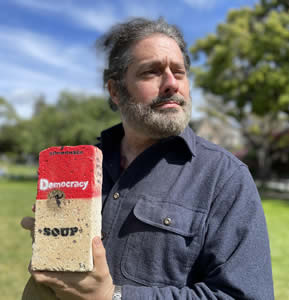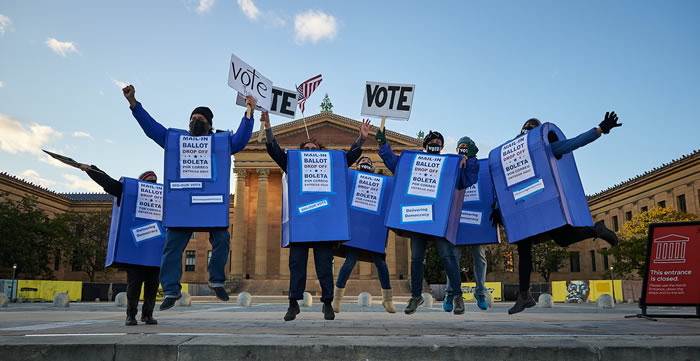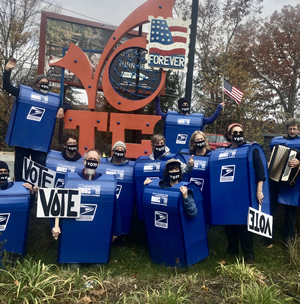
Viewers of evening news broadcasts last fall likely caught glimpses of author and performance studies alumnus L. M. Bogad (GC97, GC01) protesting in city streets. But the 2021 Guggenheim fellow and chair of the Department of Theatre and Dance at the University of California, Davis, may have gone unrecognized—thanks to the blue United States Postal Service mailbox replica he was wearing.
In 2020 Bogad founded Delivering Democracy, a coordinated group of pro-democracy, mailbox-wearing activists that danced through protests in defense of mail-in voting ahead of the November 2020 presidential election.
“It’s mobilized dadaism, weaponized surrealism, dreamlike, surfing on the collective unconscious anxiety around this issue of voting and cheating and stealing,” he says. “What is the image I can create that will make a point and raise the cost of repression tremendously? You’re going to start screaming, yelling at, and pepper spraying dancing mailboxes? I’ll take a punch for that. This is going to amplify the message.”
Bogad’s research in performance and activism has taken him to the worldwide front lines of protests for decades. In 2003 he cofounded the Clandestine Insurgent Rebel Clown Army (a name intentionally using words that are red flags in internet searches), which fused civil disobedience, clowning, improv, and theatre to raise awareness for chosen causes. Marching in formation, the clowns were mediagenic and highly informed on the issues but could quickly defuse tension with police. The performances were “tactical” in that they lacked money and raw force, but their playfulness got noticed—and often helped keep the peace.

“The agents of the state know it’s politically more expensive to club a clown,” he says.
Which is where the mailboxes came in. As fascism threatened the presidential election, Bogad and his collaborators identified the simple blue box as a universally appreciated meme of democracy. They coalesced, rehearsed, and toured the battleground state of Pennsylvania, eventually ending in Philadelphia, which was a target of disinformation campaigns and threats of voter suppression. They carried simple signs and let the televised images of dancing mailboxes communicate their message worldwide. “We had become one of the mascots of the resistance,” he says.

Coming off a year rife with outrage—over the police killings of Black Americans, the sabotage of COVID-19 response, and the violent and contentious election cycle—activists like Bogad had their pick of causes to support but ran the serious risk of burnout.
“This idea of permaculture can apply to the body of the activist,” he says. “It has to be sustainable. You have to survive and to thrive. When you’re out there in the world doing activism, it doesn’t always have to be funny, but it has to be joyful in some way. You can do something that’s very earnest and mournful and expresses grief, and yet the joy comes from the defiance.”
Bogad’s fourth book, Performing Truth, comes out in November.
